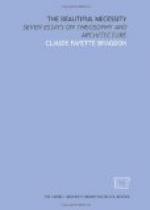In tracing everything back to the logarithmic spiral (which embodies the principle of extreme and mean ratios) I consider that Mr. Hambidge has made one of those generalizations which reorganizes the old knowledge and organizes the new. It would be only natural if in his immersion in his idea he overworks it, but Mr. Hambidge is a man of such intellectual integrity and thoroughness of method that he may be trusted not to warp the facts to fit his theories. The truth of the matter is that the entire field of research into the mathematics of Beauty is of such richness that wherever a man plants his metaphysical spade he is sure to come upon “pay dirt.” The Beautiful Necessity represents the result of my own prospecting; Dynamic Symmetry represents the result of his. If at any point our findings appear to conflict, it is less likely that one or the other of us is mistaken than that each is right from his own point of view. Be that as it may, I should be the last man in the world to differ from Mr. Hambidge, for if he convicted me of every conceivable error his work would still remain the greatest justification and confirmation of my fundamental contention—that art is an expression of the world order and is therefore orderly, organic; subject to mathematical law, and susceptible of mathematical analysis.
CLAUDE BRAGDON
Rochester, N.Y.
April, 1922
I
THE ART OF ARCHITECTURE
One of the advantages of a thorough assimilation of what may be called the theosophic idea is that it can be applied with advantage to every department of knowledge and of human activity: like the key to a cryptogram it renders clear and simple that which before seemed intricate and obscure. Let us apply this key to the subject of art, and to the art of architecture in particular, and see if by so doing we may not learn more of art than we knew before, and more of theosophy too.
The theosophic idea is that everything is an expression of the Self—or whatever other name one may choose to give to that immanent unknown reality which forever hides behind all phenomenal life—but because, immersed as we are in materiality, our chief avenue of knowledge is sense perception, a more exact expression of the theosophic idea would be: Everything is the expression of the Self in terms of sense. Art, accordingly, is the expression of the Self in terms of sense. Now though the Self is one, sense is not one, but manifold: and therefore there are arts, each addressed to some particular faculty or group of faculties, and each expressing some particular quality or group of qualities of the Self. The white light of Truth is thus broken up into a rainbow-tinted spectrum of Beauty, in which the various arts are colors, each distinct, yet merging one into another—poetry into music; painting into decoration; decoration becoming sculpture; sculpture—architecture, and so on.




